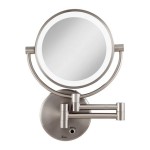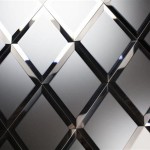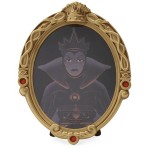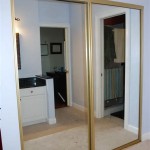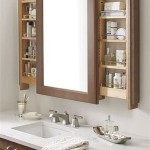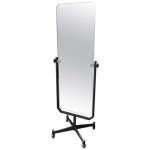Is There a TV That Also Mirrors?
The concept of a TV that doubles as a mirror has gained significant traction in recent years, driven by the desire for streamlined interior design and multifunctional technology. This article explores the current landscape of TV mirrors, examining the available technologies and their respective advantages and disadvantages.
Key Features of Mirror TVs
Several key features define the functionality and aesthetic appeal of mirror TVs:
- Reflectivity: The mirror's ability to accurately reflect images is paramount. High-quality mirror TVs prioritize excellent reflectivity when the television is off.
- Picture Quality: Image clarity, resolution, and color accuracy are crucial for a satisfactory viewing experience.
- Sound Quality: Integrated sound systems or compatibility with external audio solutions contribute to the overall immersive experience.
- Smart Functionality: Integration with streaming platforms and other smart features enhances the TV's versatility.
- Customization: Options for frame styles, sizes, and installation methods allow for seamless integration with various interior designs.
- Durability: Resistance to humidity and other environmental factors is essential, especially for bathroom installations.
- Price: Mirror TVs typically fall within a higher price bracket compared to traditional televisions.
Two Primary Technologies for Mirror TVs
Two primary technologies underpin the creation of mirror TVs: two-way mirrors and specialized dielectric glass.
Two-Way Mirror Technology
Two-way mirrors, also known as partially reflective mirrors, partially transmit light while reflecting the remainder. When a TV is placed behind a two-way mirror, the mirror reflects the surrounding environment when the TV is off. When the TV is on, the light emitted by the display passes through the mirror, making the image visible.
Dielectric Mirror TV Technology
Dielectric mirrors utilize advanced coatings to achieve a specific level of reflectivity and light transmission. These coatings allow for a higher degree of customization in terms of reflectivity and image clarity compared to traditional two-way mirrors. Dielectric mirror TVs often result in a superior image display when the TV is on and a clearer mirror reflection when off.
Advantages of Mirror TVs
Mirror TVs offer several distinct advantages in modern living spaces.
- Space Saving: Combining the functionality of a mirror and a TV frees up valuable wall space, particularly beneficial in smaller apartments or rooms.
- Aesthetics: Mirror TVs contribute to a cleaner, less cluttered aesthetic by concealing the television when not in use. They can blend seamlessly with existing decor.
- Increased Functionality: The dual-purpose nature maximizes the utility of a single piece of technology.
Disadvantages of Mirror TVs
Despite their advantages, mirror TVs also present certain drawbacks.
- Cost: Mirror TVs generally command a higher price point than comparable-sized traditional televisions due to the specialized technology involved.
- Image Quality: While advancements in technology have significantly improved picture quality, mirror TVs may not achieve the same level of brightness and contrast as dedicated high-end televisions.
- Installation: Installing a mirror TV can be more complex than installing a standard TV, often requiring professional assistance.
- Viewing Angle: The partially reflective surface of the mirror can sometimes limit the optimal viewing angle.
Applications of Mirror TVs
Mirror TVs have found applications in a variety of settings:
- Bathrooms: A mirror TV can seamlessly integrate into a bathroom vanity, providing entertainment while getting ready.
- Bedrooms: Mirror TVs can save space and maintain a clean aesthetic in bedrooms, offering a convenient viewing experience.
- Living Rooms: In larger living spaces, mirror TVs can act as a focal point, transforming into a display when desired.
- Gyms: Mirror TVs can be integrated into gym mirrors, providing entertainment during workouts.
- Commercial Spaces: Retail stores, hotels, and restaurants utilize mirror TVs for displays, information dissemination, and entertainment.
Choosing the Right Mirror TV
Selecting the appropriate mirror TV involves careful consideration of several factors:
- Size and Aspect Ratio: Choosing the correct size and aspect ratio is crucial for optimal viewing and integration within the intended space.
- Mirror Type: Consider the differences between two-way mirrors and dielectric mirrors in terms of reflectivity and image quality.
- Smart Features: Evaluate the availability of smart features such as streaming capabilities and app integration.
- Installation Requirements: Assess the installation process and determine whether professional installation is necessary.
- Budget: Determine a realistic budget based on desired features and size.
The Future of Mirror TVs
The technology behind mirror TVs continues to evolve. Advancements in display technology, such as OLED and microLED, promise even greater image quality and improved reflectivity in future mirror TV iterations. Furthermore, ongoing research and development efforts are likely to yield thinner and more energy-efficient designs. The integration of smart home technologies and voice control will further enhance the user experience.

Tv Mirrors For Sg Interior Designers Previously Overmantels

21 5 Inch Touch Screen Mirror Ip66 Waterproof Tv For Bathroom Shower Support 360 Rotation 500 Nits High Brightness Full Hd 1080p Led Built In Android 11 0 Leosmjmg 215 Leotachi

Dielectric Tv Mirror Framing Dawsons Picture

Mirrorvue Magic Mirror Tv Technology Custom Made To Any Size And Shape Great For Use In The Bathroom Livi Wall Living Room

Everything You Need To Know Before A Tv Mirror For Bathroom Mirplushome

3840 X 2160 Pixels Mirror Tv Screen Size 43 Inch At Rs 250000 Unit In Delhi

Built In Tv The Bathroom Mirror Picture Of Fairmont Pacific Rim Vancouver Tripadvisor
Aero Waterproof Mirror Tv Screen Size 32 Inch At Rs 415000 Piece1 In New Delhi

Leaner Tv Mirror With Black Frame Framing To A T

What Is Screen Mirroring And How Do I Use It With My Samsung Tv Mobile Device

